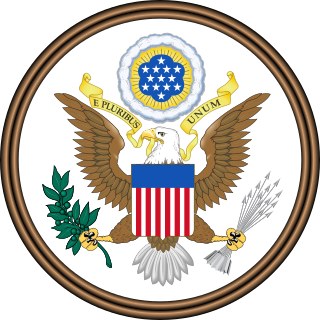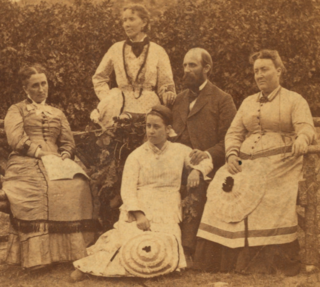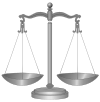
The First Amendment to the United States Constitution prevents the government from making laws respecting an establishment of religion; prohibiting the free exercise of religion; or abridging the freedom of speech, the freedom of the press, the freedom of assembly, or the right to petition the government for redress of grievances. It was adopted on December 15, 1791, as one of the ten amendments that constitute the Bill of Rights.
West Virginia State Board of Education v. Barnette, 319 U.S. 624 (1943), is a landmark decision by the United States Supreme Court holding that the First Amendment protects students from being compelled to salute the American flag or say the Pledge of Allegiance in public schools.
Minersville School District v. Gobitis, 310 U.S. 586 (1940), was a decision by the Supreme Court of the United States restricting the religious rights of public school students under the First Amendment to the United States Constitution. The Court ruled that public schools could compel students—in this case, Jehovah's Witnesses—to salute the American flag and recite the Pledge of Allegiance despite the students' religious objections to these practices. This decision led to increased persecution of Witnesses in the United States. The Supreme Court overruled this decision three years later in West Virginia State Board of Education v. Barnette (1943).

The Religious Freedom Restoration Act of 1993, Pub. L. No. 103-141, 107 Stat. 1488, codified at 42 U.S.C. § 2000bb through 42 U.S.C. § 2000bb-4, is a 1993 United States federal law that "ensures that interests in religious freedom are protected." The bill was introduced by Congressman Chuck Schumer (D–NY) on March 11, 1993. A companion bill was introduced in the Senate by Ted Kennedy (D-MA) the same day. A unanimous U.S. House and a nearly unanimous U.S. Senate—three senators voted against passage—passed the bill, and President Bill Clinton signed it into law.
Church of the Lukumi Babalu Aye, Inc. v. Hialeah, 508 U.S. 520 (1993), was a case in which the Supreme Court of the United States held that an ordinance passed in Hialeah, Florida, forbidding the "unnecessar[y]" killing of "an animal in a public or private ritual or ceremony not for the primary purpose of food consumption", was unconstitutional.

Reynolds v. United States, 98 U.S. 145 (1878), was a Supreme Court of the United States case that held that religious duty was not a defense to a criminal indictment. Reynolds was the first Supreme Court opinion to address the First Amendment's protection of religious liberties, impartial juries and the Confrontation Clauses of the Sixth Amendment.
In United States law, the Establishment Clause of the First Amendment to the United States Constitution, together with that Amendment's Free Exercise Clause, form the constitutional right of freedom of religion. The relevant constitutional text is:
Congress shall make no law respecting an establishment of religion...
Freedom of religion in the Philippines is guaranteed by the Constitution of the Philippines.

The Religious Land Use and Institutionalized Persons Act (RLUIPA), Pub. L.Tooltip Public Law 106–274 (text)(PDF), codified as 42 U.S.C. § 2000cc et seq., is a United States federal law that prohibits the imposition of burdens on the ability of prisoners to worship as they please and gives churches and other religious institutions a way to avoid zoning law restrictions on their property use. It also defines the term "religious exercise" to include "any exercise of religion, whether or not compelled by, or central to, a system of religious belief." RLUIPA was enacted by the United States Congress in 2000 to correct the problems of the Religious Freedom Restoration Act (RFRA) of 1993. The act was passed in both the House of Representatives and the Senate by unanimous consent in voice votes, meaning that no objection was raised to its passage, so no written vote was taken. The S. 2869 legislation was enacted into law by the 42nd President of the United States Bill Clinton on September 22, 2000.
Employment Division, Department of Human Resources of Oregon v. Smith, 494 U.S. 872 (1990), is a United States Supreme Court case that held that the state could deny unemployment benefits to a person fired for violating a state prohibition on the use of peyote even though the use of the drug was part of a religious ritual. Although states have the power to accommodate otherwise illegal acts performed in pursuit of religious beliefs, they are not required to do so.
Locke v. Davey, 540 U.S. 712 (2004), is a United States Supreme Court decision upholding the constitutionality of a Washington publicly funded scholarship program which excluded students pursuing a "degree in devotional theology". This case examined the "room ... between the two Religion Clauses", the Free Exercise Clause and the Establishment Clause.
Cantwell v. Connecticut, 310 U.S. 296 (1940), is a landmark court decision by the United States Supreme Court holding that the First Amendment's federal protection of religious free exercise incorporates via the Due Process Clause of the Fourteenth Amendment and so applies to state governments too.
Sherbert v. Verner, 374 U.S. 398 (1963), was a case in which the Supreme Court of the United States held that the Free Exercise Clause of the First Amendment required the government to demonstrate both a compelling interest and that the law in question was narrowly tailored before it denied unemployment compensation to someone who was fired because her job requirements substantially conflicted with her religion.

In the United States, freedom of religion is a constitutionally protected right provided in the religion clauses of the First Amendment. As stated in the Bill of Rights: "Congress shall make no law respecting an establishment of religion, or prohibiting the free exercise thereof...". George Washington stressed freedom of religion as a fundamental American principle even before the First Amendment was ratified. In 1790, in a letter to the Touro Synagogue, he expressed the government “gives to bigotry no sanction” and “to persecution no assistance." Freedom of religion is linked to the countervailing principle of separation of church and state, a concept advocated by Colonial founders such as Dr. John Clarke, Roger Williams, William Penn, and later Founding Fathers such as James Madison and Thomas Jefferson.
Tucker v. Texas, 326 U.S. 517 (1946), was a case in which the Supreme Court of the United States held that a state statute making it an offense to distribute literature in a federal government-owned town was an improper restriction on freedom of the press and religion.
Lyng v. Northwest Indian Cemetery Protective Association, 485 U.S. 439 (1988), was a United States Supreme Court landmark case in which the Court ruled on the applicability of the Free Exercise Clause to the practice of religion on Native American sacred lands, specifically in the Chimney Rock area of the Six Rivers National Forest in California. This area, also known as the High Country, was used by the Yurok, Karuk, and Tolowa tribes as a religious site.
United States v. Lee, 455 U.S. 252 (1982), was a United States Supreme Court case establishing precedent regarding the limits of free exercise of religious conscience by employers.
Fulton v. City of Philadelphia, 593 U.S. ___ (2021), was a United States Supreme Court case dealing with litigation over discrimination of local regulations based on the Free Exercise Clause and Establishment Clause of the First Amendment to the United States Constitution. The specific case deals with a religious-backed foster care agency that was denied a new contract by the City of Philadelphia, Pennsylvania, due to the agency's refusal to certify married same-sex couples as foster parents on religious grounds.
A religious exemption is a legal privilege that exempts members of a certain religion from a law, regulation, or requirement. Religious exemptions are often justified as a protection of religious freedom, and proponents of religious exemptions argue that complying with a law against one's faith is a greater harm than complying against a law that one otherwise disagrees with due to a fear of divine judgment. Opponents of religious exemptions argue that they mandate unequal treatment and undermine the rule of law.




